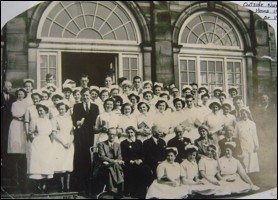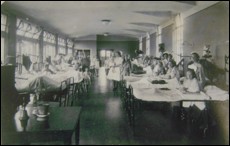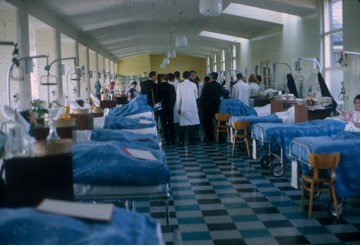|
|
||||||||||||||
|
|
Wrightington HistoryThe History of Wrightington Hospital
The Hall was finally bought by Lancashire County Council in 1918 for £16,473 with the purpose of turning it into a TB Hospital. This was following the work of Robert Koch in 1882 who first recognised TB as an infection. Later in 1911 a Royal Commission link human and bovine TB. Subsequently the Astor Report in 1913 recommended instigation of TB sanatoria. The 226 bed Hospital was created between 1929- 1931 for a cost of £129,520 and the first patient, a 9 year old boy from Ashton with TB of the spine was admitted in 1931 The formal opening of the hospital was on the 16th June 1933. Photographs showing the wards in the 1940(above) and in 1967(below).
The typical length of stay was often over a year and the first patient mentioned above stayed for 18 months being treated in a "spinal box" with psoas abscess injections. Parental visits were only allowed on the first Saturday of the month, a far cry from modern visiting times. The treatments mostly consisted of rest and fresh air - often meaning that patients' beds were placed outside on the veranda overnight. Patients have recalled stories of waking up in the morning, leaning down out of bed and making snowballs!! Sir Robert Jones, the famous Orthopaedic Surgeon was the first surgical advisor to Wrightington Hospital . He was followed by Sir Harry Platt (Manchester) and McMurray (Liverpool) both consulting surgeons. Apparently McMurray visited on Sundays, operating if required and would then play badminton followed by a roast lunch in the board room! John Charnley then became consulting orthopaedic surgeon to Wrightington Hospital. The Medical Superintendents at Wrightington were Pask and then Dobson. The treatment initially was rest, fresh air, food and artificial light. Dobson was involved in the research that identified Streptomycin as the first successful drug treatment for TB in 1943. Following the implementation of drug treatment for TB the numbers of inpatients dramatically fell at Wrightington. This coincided with John Charnley's work on total hip replacement and his need to find a hospital in which to set up a dedicated unit. Sir John was disillusioned with the managerial red tape that prevented him progressing at Manchester Royal Infirmary and moved out to set up the Centre for Hip Surgery at Wrightington. For more detail on the history of hip replacement development click here John Charnley entertaining visiting American surgeons outside the Centre for Hip Surgery in 1967.
|
| Medical Marketing by Blue Medical |









 Wrightington Hall was built in 1282 and was kept in the Wrightington family until 1658 when Sir Edward Wrightington died. The Hall and Estate then passed down through the generations of the families of Dicconson, Eccleston, Scarisbrick, Clifton-Dicconson and finally the Gerard-Dicconsons.
Wrightington Hall was built in 1282 and was kept in the Wrightington family until 1658 when Sir Edward Wrightington died. The Hall and Estate then passed down through the generations of the families of Dicconson, Eccleston, Scarisbrick, Clifton-Dicconson and finally the Gerard-Dicconsons. 

